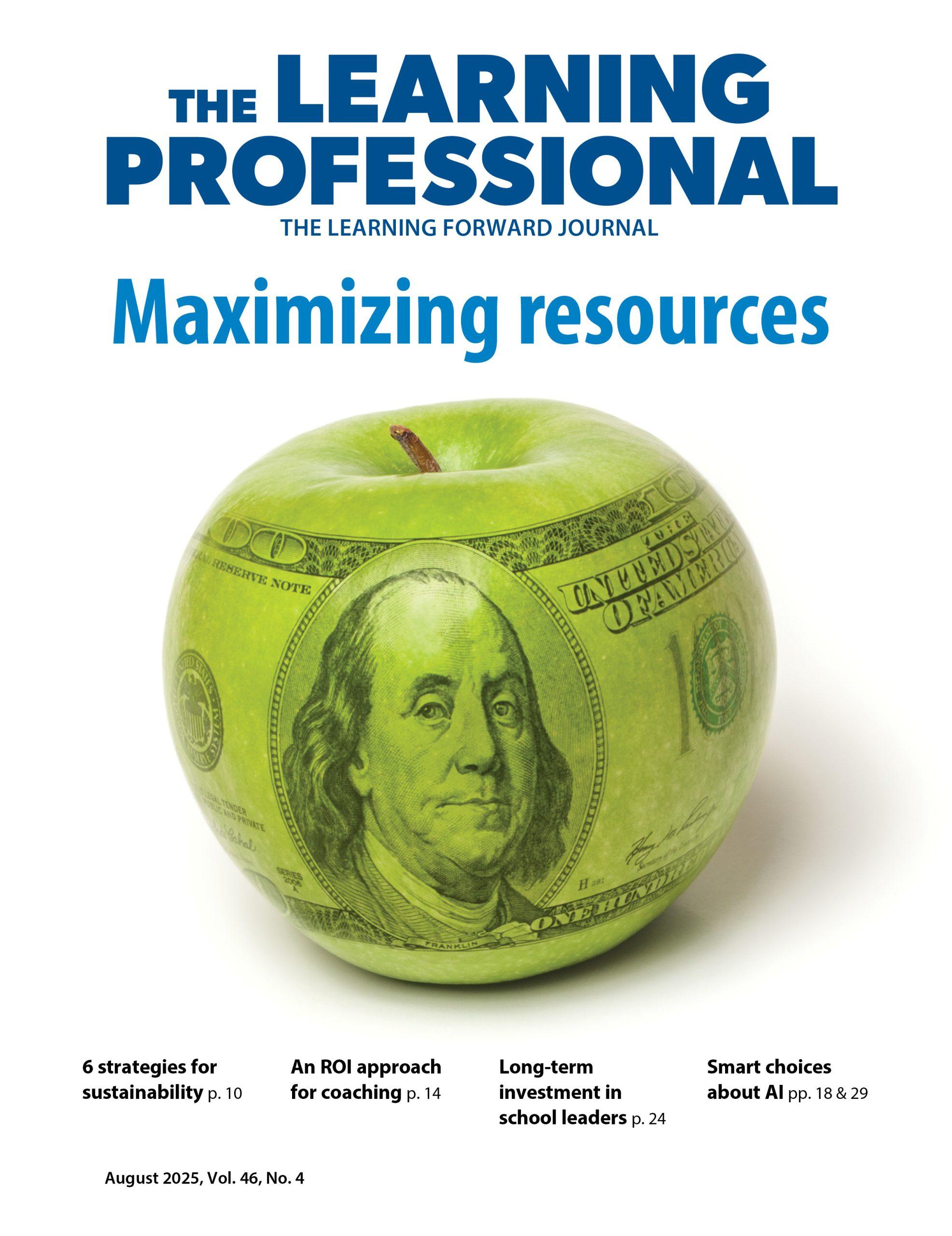Partners In learning
Teacher leaders drive instructional excellence
By Learning Forward
December 2013
Read the remaining content with membership access. Join or log in below to continue.
Sed ut perspiciatis unde omnis iste natus error sit voluptatem accusantium doloremque laudantium, totam rem aperiam, eaque ipsa quae ab illo inventore veritatis et quasi architecto beatae vitae dicta sunt explicabo. Nemo enim ipsam voluptatem quia voluptas sit aspernatur aut odit aut fugit, sed quia consequuntur magni dolores eos qui ratione voluptatem sequi nesciunt. Neque porro quisquam est, qui dolorem ipsum quia dolor sit amet, consectetur, adipisci velit, sed quia non numquam eius modi tempora incidunt ut labore et dolore magnam aliquam quaerat voluptatem.
About the Center for Results
Learning Forward’s Center for Results supports education leaders in developing systems to improve educator effectiveness and student achievement. The center offers high-impact consulting and programs strictly aligned with Learning Forward’s research and body of knowledge in effective professional learning to support deep implementation in schools. For more information, visit www.learningforward.org/centerforresults.
About the Initiative
Since 2012, Learning Forward’s Center for Results has supported 12 high-profile school systems to leverage professional learning to improve educator effectiveness. Sites participating in the Bill & Melinda Gates Foundation-funded network, called the Supporting Effective Teaching Knowledge Development Initiative, applied and collaboratively refined the framework and tools presented in the report, Supporting Effective Teaching: Professional Learning Insights from 12 Leading Districts (Duff & Islas, in press), from which this article is adapted.
Participating sites found the tools helpful in identifying gaps in existing professional learning, planning for future professional learning, and evaluating the impact of professional learning.
The full report offers an analysis of key lessons learned across the 12 sites. Participants identified these key concepts in discussion, reflection, and implementation of creating their learning systems:
1. Clarify the purposes of professional learning;
2. Identify roles and responsibilities for professional learning;
3. Create differentiated learning to meet all teachers’ needs;
4. Monitor the impact of professional learning; and
5. Drive instructional excellence by supporting teacher leaders.
Reference
Duff, V. & Islas, M.R. (in press). Supporting effective teaching: Professional learning insights from 12 leading districts. Seattle, WA: Bill & Melinda Gates Foundation.
Teacher leaders in Hillsborough County
Hillsborough County (Fla.) Public Schools offers leadership opportunities to teachers through its Empowering Effective Teachers program. Highly effective teachers may apply to become peer observers, mentors, or connectors.
Each teacher leader role has distinct responsibilities:
Peer observers work with veteran teachers, observing teachers multiple times a year, providing feedback and input on a teacher’s evaluation.
Peer mentors provide support to new teachers on a weekly basis by observing and providing feedback, modeling lessons, co-teaching and conferencing, and offering input on evaluation.
Peer connectors offer support to a school for teachers who want to know more about the evaluation rubric and process.
For more information on the program, visit https://communication.sdhc.k12.fl.us/empoweringteachers.
Guiding Questions on Teacher Leadership
| Guiding questions on teacher leadership | |
| Teacher leadership can promote deeper learning of all educators tied to improved student achievement. Use the following questions to guide a discussion to articulate the intended outcomes for leveraging the knowledge and skills of teacher leaders. | |
| 1 | What is the district’s vision for implementing a teacher leadership model?
Who will help determine the vision? What expertise resides in the district to meet the vision? How is the vision aligned to student learning goals? |
| 2 | How will the district leverage the expertise of high-performing teachers to facilitate improvement in instruction and support district priorities (e.g. educator effectiveness, college- and career-ready standards, assessment literacy)? |
| 3 | What specific roles and responsibilities will teacher leaders take on in various efforts? |
| 4 | What criteria will be used to determine how teacher leaders will be selected? |
| 5 | How will school leaders be supported in developing the culture for teacher leadership? |
| 6 | How will teacher leaders be supported in their work? |
| 7 | How will the intentional use of teacher leadership be communicated?
What are the expectations for leaders? What are the expectations for teacher leaders? How will teachers work with and share learning with teacher leaders? What are the benefits of teacher leadership? How will challenges be addressed? |
| 8 | How will the teacher leadership program be monitored? How will results be used to make improvements? |
References
Curtis, R. (2013, February). Finding a new way: Leveraging teacher leadership to meet unprecedented demands. Washington, DC: Aspen Institute.
Katzenmeyer, K. & Moller, G. (2009). Awakening the sleeping giant. Thousand Oaks, CA: Corwin.
Leithwood, M., Louis, K.S., Anderson, S., & Wahlstrom, K. (2004). How leadership influences student learning. New York, NY: The Wallace Foundation.
Louis, K.S. & Marks, H. (1998). Does professional community affect the classroom? Teachers’ work and student experiences in restructuring schools. American Journal of Education, 106(4), 532-575.
York-Barr, J. & Duke, K. (2004, Fall). What do we know about teacher leadership? Findings from two decades of scholarship. Review of Educational Research, 74(3), 255-316.
Learning Forward is the only professional association devoted exclusively to those who work in educator professional development. We help our members plan, implement, and measure high-quality professional learning so they can achieve success with their systems, schools, and students.
Recent Issues
MEASURING LEARNING
June 2025
To know if your professional learning is successful, measure educators’...
NAVIGATING NEW ROLES
April 2025
Whether you’re new to your role or supporting others who are new,...
LEARNING DESIGNS
February 2025
How we learn influences what we learn. This issue shares essential...
BUILDING BRIDGES
December 2024
Students benefit when educators bridge the continuum of professional...









